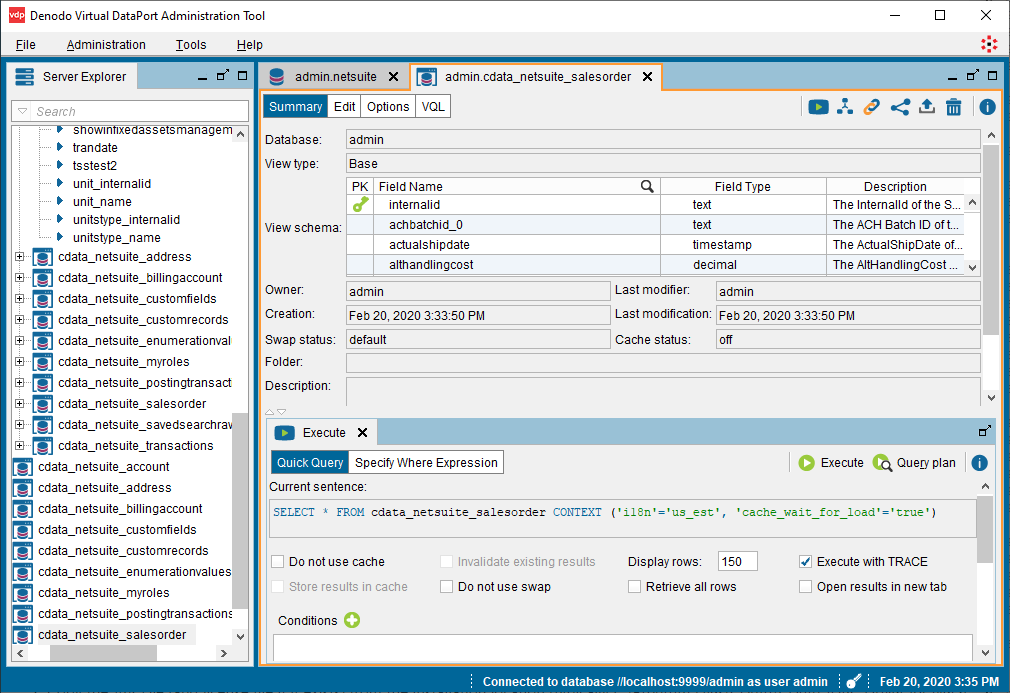Discover how a bimodal integration strategy can address the major data management challenges facing your organization today.
Get the Report →Connect to QuickBooks Data in the Denodo Platform
Use CData driver technologies to create a virtual data source for QuickBooks data in the Denodo Virtual DataPort Administrator.
Denodo Platform is a data virtualization product providing a single point of contact for enterprise database data. When paired with the CData JDBC Driver for QuickBooks, Denodo users can work with live QuickBooks data alongside other enterprise data sources. This article walks through creating a virtual data source for QuickBooks in the Denodo Virtual DataPort Administrator.
With built-in optimized data processing, the CData JDBC Driver offers unmatched performance for interacting with live QuickBooks data. When you issue complex SQL queries to QuickBooks, the driver pushes supported SQL operations, like filters and aggregations, directly to QuickBooks and utilizes the embedded SQL engine to process unsupported operations client-side (often SQL functions and JOIN operations). Its built-in dynamic metadata querying allows you to work with and analyze QuickBooks data using native data types.
About QuickBooks Data Integration
CData simplifies access and integration of live QuickBooks data. Our customers leverage CData connectivity to:
- Access both local and remote company files.
- Connect across editions and regions: QuickBooks Premier, Professional, Enterprise, and Simple Start edition 2002+, as well as Canada, New Zealand, Australia, and UK editions from 2003+.
- Use SQL stored procedures to perform actions like voiding or clearing transactions, merging lists, searching entities, and more.
Customers regularly integrate their QuickBooks data with preferred tools, like Power BI, Tableau, or Excel, and integrate QuickBooks data into their database or data warehouse.
Getting Started
Create the QuickBooks Virtual Port
To connect to live QuickBooks data from Denodo, you need to copy the JDBC Driver JAR file to the external library directory for Denodo and create a new JDBC Data Source from the Virtual DataPort Administrator tool.
- Download the CData JDBC Driver for QuickBooks installer, unzip the package, and run the JAR file to install the driver.
- Copy the JAR File (and license file if it exists) from the installation location (typically C:\Program Files\CData\CData JDBC Driver for QuickBooks\lib\) to the Denodo external library directory (C:\Denodo\Denodo Platform\lib-external\jdbc-drivers\cdata-quickbooks-19).
- Open the Denodo Virtual DataPort Administrator tool and navigate to the Server Explorer tab.
- Right-click "admin" and select New -> Data source -> JDBC.
![Creating a new JDBC data source.]()
- Configure the JDBC Connection:
- Name: your choice, e.g.: quickbooks
- Database adapter: Generic
- Driver class path: C:\Denodo\Denodo Platform\lib-external\jdbc-drivers\cdata-quickbooks-19
- Driver class: cdata.jdbc.quickbooks.QuickBooksDriver
Database URI: Set this to a JDBC URL using the necessary connection properties. For example,
jdbc:quickbooks:URL=http://remotehost:8166;User=admin;Password=admin123;
![Configuring the JDBC connection (NetSuite is shown).]()
Information on creating the Database URI follows:
Built-In Connection String Designer
For assistance in constructing the JDBC URL, use the connection string designer built into the QuickBooks JDBC Driver. Either double-click the JAR file or execute the jar file from the command-line.
java -jar cdata.jdbc.quickbooks.jarFill in the connection properties and copy the connection string to the clipboard.
When you are connecting to a local QuickBooks instance, you do not need to set any connection properties.
Requests are made to QuickBooks through the Remote Connector. The Remote Connector runs on the same machine as QuickBooks and accepts connections through a lightweight, embedded Web server. The server supports SSL/TLS, enabling users to connect securely from remote machines.
The first time you connect, you will need to authorize the Remote Connector with QuickBooks. See the "Getting Started" chapter of the help documentation for a guide.
![Using the built-in connection string designer to generate a JDBC URL (Salesforce is shown.)]()
- Click the "Test connection" button to confirm the configuration and click Save.
View QuickBooks Data in the VirtualPort Administrator Tool
After creating the data source, you can create a base view of QuickBooks data for use in the Denodo Platform.
- Click the "Create base view" button in the newly created VirtualPort (admin.QuickBooks).
- Expand the object tree and select the objects (tables) you wish to import.
![Selecting objects to import (NetSuite is shown).]()
- Click the "Create selected" button to create views of the QuickBooks data.
Optional: Click "Create associations from foreign keys" to define relationships between the objects. - With the view(s) created, navigate to a table (cdata_quickbooks_customers) in the Server Explorer and double-click the selected table.
- In the new tab, click "Execution panel" to open a query panel.
- Customize the query in the "Execute" tab or use the default:
SELECT * FROM cdata_quickbooks_customers CONTEXT ('i18n'='us_est', 'cache_wait_for_load'='true')![Configuring the query to view the data.]()
- Click Execute to view the data.
![Viewing the data.]()
With the base view created, you can now work with live QuickBooks data like you would any other data source in Denodo Platform, for example, querying QuickBooks in the Denodo Data Catalog.
Download a free, 30-day trial of the CData JDBC Driver for QuickBooks and start working with your live QuickBooks data in Denodo Platform. Reach out to our Support Team if you have any questions.











